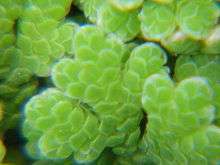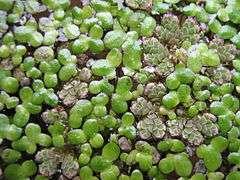Azolla filiculoides
Azolla filiculoides (water fern) is a species of Azolla, native to warm temperate and tropical regions of the Americas as well as most of the old world including Asia and Australia.
| Azolla filiculoides | |
|---|---|
 | |
| Zoomed picture of Azolla filiculoides | |
| Scientific classification | |
| Kingdom: | Plantae |
| Clade: | Tracheophytes |
| Class: | Polypodiopsida |
| Order: | Salviniales |
| Family: | Salviniaceae |
| Genus: | Azolla |
| Species: | A. filiculoides |
| Binomial name | |
| Azolla filiculoides | |
| Synonyms[2][3] | |
| |
It is a floating aquatic fern, with very fast growth, capable of spreading over lake surfaces to give complete coverage of the water in only a few months. Each individual plant is 1–2 cm across, green tinged pink, orange or red at the edges, branching freely, and breaking into smaller sections as it grows. It is not tolerant of cold temperatures and, in temperate regions it largely dies back in winter, surviving by means of submerged buds. Like other species of Azolla, it can fix nitrogen from the air.
Fossil records from as recent as the last interglacials are known from several locations in Europe (Hyde et al. 1978).
Azolla filiculoides is one of just two fern species for which a reference genome has been published.[4][5]
Identification
The only sure method of distinguishing this species from Azolla cristata (long incorrectly known as A. caroliniana) is to examine the trichomes on the upper surfaces of the leaves. Trichomes are small protuberances that create water resistance. They are unicellular in A. filiculoides but septate (two-celled) in A. cristata.[6]
Cultivation
The species has been introduced to many regions of the Old World, grown for its nitrogen-fixing ability that may be used to enhance the growth rate of crops grown in water, such as rice, or by removal from lakes for use as green manure. It has become naturalized, sometimes also an invasive species, in several regions, including western Europe, southern Africa, tropical Asia and New Zealand.
Distribution
Ireland: Introduced into Clandeboye Lake, Co. Down.[7]
Gallery
References
- In: Encyclopédie Méthodique, Botanique 1(1): 343. 1783. "Name - Azolla Lam". Tropicos. Saint Louis, Missouri: Missouri Botanical Garden. Retrieved February 19, 2010.
Annotation: a sp. nov. reference for Azolla filiculoides
Type Specimens HT: Azolla filiculoides - Hussner, A. (2006). "NOBANIS -- Invasive Alien Species Fact Sheet -- Azolla filiculoides" (PDF). Online Database of the North European and Baltic Network on Invasive Alien Species. Heinrich Heine University, Düsseldorf. Retrieved February 19, 2010.
- Tropicos
- Li, Fay-Wei; Brouwer, Paul; Carretero-Paulet, Lorenzo; Cheng, Shifeng; de Vries, Jan; Delaux, Pierre-Marc; Eily, Ariana; Koppers, Nils; Kuo, Li-Yaung (2018-07-02). "Fern genomes elucidate land plant evolution and cyanobacterial symbioses". Nature Plants. 4 (7): 460–472. doi:10.1038/s41477-018-0188-8. ISSN 2055-0278. PMC 6786969. PMID 29967517.
- E360 Digest, Can A Tiny Fern Help Fight Climate Change and Cut Fertilizer Use?, Yale Environment 360, July 11, 2018
- Evrard, C.; Van Hove, C. (2004). "Taxonomy of the American Azolla Species (Azollaceae): A Critical Review". Systematics and Geography of Plants. 74 (2): 301–318.
- Hackney, P. (Ed) 1992. Stewart & Corry's Flora of the North-east of Ireland. Third Edition. Institute of Irish Studies & The Queen's University of Belfast. ISBN 0-85389-446-9(HB)
Further reading
- Hyde, H. A., Wade, A. E., & Harrison, S. G. (1978). Welsh Ferns. National Museum of Wales. ISBN 0-7200-0210-9.
- Sainty, G. & Jacobs, S. (2003) Waterplants in Australia. Sainty and Associates, Potts Point, Sydney, Australia. ISBN 0-9581055-1-0
External links

- "Azolla filiculoides". Germplasm Resources Information Network (GRIN). Agricultural Research Service (ARS), United States Department of Agriculture (USDA).
- Flora of North America: Azolla filiculoides
- USDA Plants Profile: Azolla filiculoides
- Plants for a Future: Azolla filiculoides
- NSW Flora Online: Azolla filiculoides

